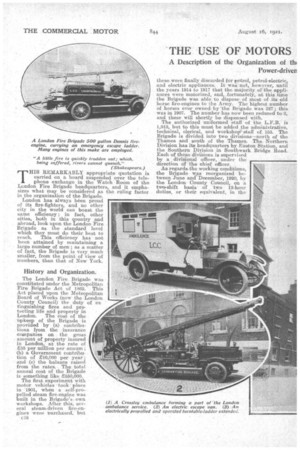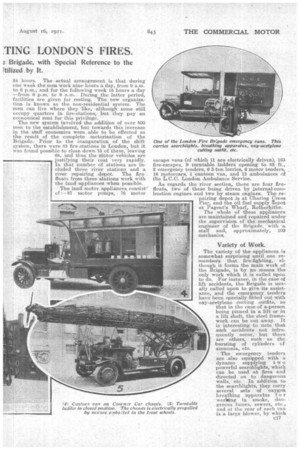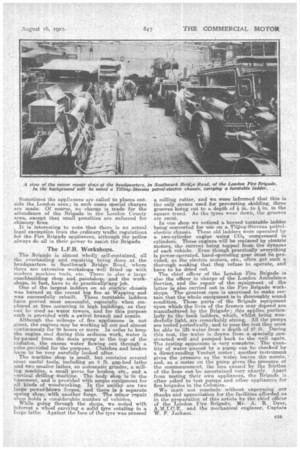THE USE OF MOTORS .TING LONDON S FIRES.
Page 12

Page 13

Page 14

Page 15

If you've noticed an error in this article please click here to report it so we can fix it.
A Description of the Organization of till Power-driven Brigade, with Special Reference to the rtilized by It.
THIS REMARKABLY appropriate quotation is carried on a board suspended over the telephone exchange in the Watch Room of the London Fire Brigade headquarters, and it emphasizes what may be considered as the ruling factor in the organization of the Brigade.
London has always been proud of its fire-fighters and no other city in the world can boast the same efficiency ; in fact, other cities, bath in this Qauntry and abroad, look upon the London Fire Brigade as the .standard level which they must do their best to reach. This efficiency has not been attained by maintaining a large number of men ; as a matter of fact, the Brigade is very much smaller, from the point of view of numbers, than that of New York.
History and Organization.
The London Fire. Brigade was constituted under the Metropolitan Fire Brigade Act of 1865. This Act placed upon the Metropolitan Board of Works (now the London County Council) the duty of ex. tingtushing fires and protecting life and property in London. The ebst of the fipkeep of the Brigade is provided by (a.) contributions from the insurance companies an the gross amount of property insured in London, at the rate of £35 per million per annum ; (b) a Government contribution of 210,000 per year ; and (c) the balance raised from the rates. The total annual cost of the Brigade is something like £550,000.
The first experiment with motor vehicles took place in 1901, when a self-propelled steam fire-engine was built in the Brigade's. own workshops. After this, several steam-driven fire-engines were purchased, but
c16 these were finally discarded for petrol, petrol-electric, and electric appliances. It was nut, however, until the years 1914 to 1917 that the majority of the appliances were motorized, and, fortunately, at this time the Brigade was able to dispose of most of its old horse fire-engines to the Army. The highest number of horses ever owned by the Brigade was 327; this was in 1907. The number has now been reduced to 2, and these will shortly be dispensed. with. The authorized uniformed staff of the L.F.B. is 1,913, but to this must be added the administrative, technical, clerical, and workshop staff of 153. The Brigade is divided into two divisions—north of the Thames and south of the Thames. The Northern Division has its headquarters by Ruston Station, and the Southern Division in Southwark Bridge Road. Each of these divisions is supervised by a divisional officer, under the direction of the chief officer. .
As regards.the working conditions, the Brigade w..as reorganized be
tween June and December, 1920, by the Landon County Council, on a two-shift basis. of . two 12-hour duties, or their equivalent, in the 24 hours. The actual arrangement is that during one week the men work nine hours a day, from 9 a.m. to 6 p.m., and for the following week 15 hours a day —from 6 p.m. to 9 a.m. During the latter period, facilities are given for resting. The new organization is known as the non-residential system. The men can live where they •like, • although some still occupy quarters in fire-stations, but they pay an economical rent for this privilege.
The new system involved the addition of over 800 men to the eStablishrnent, but towards this increase in the staff economies were able to be effected as the result of the complete Motorization of the Brigade. Prior to the inauguration of the shift system, there were 83 fire,stations in London, but it was found nossible• to close down 15 of these, leaving 68, and thus the motor vehicles are justifying their cost very rapidly.
In that number of stations are in cluded three river stations and a river repairing depot. The fire-. floats from these stations work with the laud •appliances when possible.
The land motor appliances, consist' of :--87 nbotor pumps, • 76 motor
escape vans (of which 11 are electrically driven), 165 fire-escapes, 9 turntable ladders opening to 82 ft., 2 emergency tenders, 8-3-ton lorries, 6 motor tenders, _ 16 motorcars, I canteen van, and 13 ambulances of the L.C.O. London Ambulance Service.
As regards the river section, there are four firefloats, two of these being driven by internal-combustion engines and two by steam engines. The repairing 'depot is at Charing Cross Pier, and the oil fuel supply depot at Pagent's Wharf, Rotherhithe.
The whole of these appliances are maintained and repaired under the supervision of the mechanical engineer of the Brigade, with 'a staff and, approximately, 100 mechanics,
Variety of Work.
The. variety of the appliances is somewhat surprising until one remembers that fire-fighting, although it forms the main work of the Brigade, is by no means the only work which it is called upon to do. For instance, in the ease of lift accidents, the Brigade is
usually called upon to give its assistance, and the emergency tenders have been specially fitted out with oxy-acetylene cutting outfits, so that in the ease-of a,person being pinned in a, lift•or iii a lift shaft, the steel framework can be cut away. It is interesting to note that such accidents not infrequently occur, but there are others, such as the bursting of cylinders of ammonia,. etc.
The • emergency tenders are also equipped with a dynamo supplying t w o powerful searchlights, which can be used at fires and directed on to dangerous walls, etc. In addition to the searchlights, they carry several sets of oxygen breathing apparatus f o r working in smoke, dangerous fumes, sewers, etc., and at the rear of each van is a. large blower, by which fresh air can be forced through a hose pipe of large bore into any place where there are fumes, the fresh , air forcing these out. One of the most interesting of the devices carried on the tender is the "lung motor," which is. worked by hand and is arranged to enable partially suffocated people to be resuscitated with air or oxygen in proper proportions. -In the case of big fires, the firemen cannot, at course, leave the outbreak in order to obtain refreshments, so a, canteen van, or coffee stall, has been built on .a
Commer Car chaseis.
Turning Out.
All the appli anoes propelled by petrol engines are vided with coil and accumulator ignition to assist starting, in addition to the ordinary magneto, and every ecigine is started up every four• hours at the stations; it is, of course, .only allowed to run for a few seconds. The ap-plianee rooms. are also warmed in winter. Thefuel used must have a specific gravity below .72 at 60 degrees F. Two plugs are provided for each 'cylinder, and during ordinary working the coil ignition system is switched off. The appliances. are very often drenched with water, and in weliecaSes. the magnetos sometimes fail. When this oc'eurs, the advantage of haying a separate ignition system is proved even more conclusively. All machines are fitted with electric lights, the current for these being supplied from accumulators. It has Itienfound useless. to use, dynamos driven from the engine, as the mileage is comparatively so low that the charging would be negligible; therefore, 4heiicaiihulators are charged from a, stationary charging Set. The watch room at the London observation is kept on all fires cc On the map at the left are Indica
The L.F.B. does not follow the practice of carrying the escape on the pump, each escape being carried on a separatevan,, and this, being the life-saving appliance, is always the first to be turned out in the case of an alarm.
At the headquarters is a watch-roan-1, where observation is kept on all fires occurring in the whole of London, and ,where the mobilization of the Brigade for all large fires is directed.
For the last twelve months the average time taken to turn out an ap,plian ce was
Kseconds; which is really
remarkable when. one considers that this.
is the actual 'number of secondstaken from the time that the 'alarm is sounded un til the appli ance crosses the threshold of the station.
A s regards the speed of turning o u t, the electric escapes have
proved very adv anta geous, providing that the runs a r e net too Req.
The total Of calls during 1920 was' 6,554, including false alarms, chimney fires, etc. The total of actual fires was 3,474, The number of street fire-alarms in London is 1,620, and the number of street hydrants 30,120. One of the advantages experienced with the use of motor vehicles is that of having an extra man at the fire with but little additional expense, as the driver, instead of having to stand with his horses, as in the old days, can now be, and is actually, empleyed on other work, such as that of controlling the pump. All the motor drivers are trained by the Brigade, special classes for this purpose beinginstituted when motors. were first adopted. The motor drivers. receive an additional payment of 2s. 6d. per week.
Sometimes the appliances are Called to places outside the London area; in such eases special charges are made. Of course, no charge is made for the attendance of the Brigade in the London County area, -except that small penalties are enforced for chimney fires.
It is interesting to note that there is no actual legal exemption from the ordinary traffic regulations for the Fire Brigade appliances, although the police always do all in their power to assist the Brigade.
The L.F.B. Workshops.
The Brigade is almost wholly self-contained, all the overhauling and repairing being done at the headquarters in Southwark Bridge Road, where there are extensive workshops "well fitted up with modern machine tools, etc. There is also a large eoachbuilding shop and .psintshop, and the work:shops, in fact, have to do practically any job. One of the largest ladders on an electric chassis was Mimed at the recent big fire at Wapping and was successfully rebuilt. These turntable ladders have proved most successful, especially, when employed at fires occurring in high buildings, as they can be used as water towers, and for this purpose each is provided with a swivel branch and nozzle.
Although the railea.ge of fire appliances is not .great,. the engines may be working all out and almost continuously for 30 hours or more. In order to keep the engine cool during this arduous work, water is by-passed from the main pump to the top of the radiator, the excess water flowing out through a tube provided for the purpose. Clutches and brakes bare to be very carefully looked after.
The machine shop is small, but contains several most -useful tools, including an 8 ft.. gap-bed lathe and two smaller lathes, an automatic grinder, a milliag machine, a. small press for bushes, etc., and a viotical drilling inaChine. The body sphop is in the basement, and is provided with ample equipment for all 'kinds of woodworking. In the smithy are two large .power-blown forges, and there is a separate spring shop, with another forge. The minor repair shoo holds a considerable number of vehicles.
While going through the shops, we noted with interest a wheel carrying a solid tyre rotating in a /arge lathe:. Against the face of the tyre was pressed a milling cutter, and we were informed that this is the only means used for preventing skidding, threegrooves being cut to a depth of i in. to in. in the
square tread. As the tyres wear down, the grooves
are recut. In one shop we noticed a horsed turntable ladder being converted for use on a. Tilling-Stevens petrol
electric chassis. These old ladders were operated by a. two-cylinder engine using CO t coMpressedin cylinders. These engines will be replaced by electric motors, the current being tapped from the dynamo of each vehicle. Even though practicAlly everything is power-operated, hand-operatmg gear must be provided, as the electric motors, etc., often get such a thorough soaking that they refuse to operate, and
have to be dried out. The chief officer of the London Fire Brigade is also the officer in charge of the London Ambulance Service, and the repair of the equipment of the latter is also carried out in the Fire Brigade workshopsThe greatest care is exercised to. make certain that the whole equipment is in thoroughly sound condition. Those parts of the Brigade equipment upon which the lives of the firemen May depend are manufactured by the Brigade; this applies particu larly to the hook ladders, which, Whilst being wonderfully light, are remarkably strong. All the pumps are tested periodically, and to miss the test they must be able to lift water from a depth-of 27 ft. During this test, the water is drawn from a specially „eonstracted well and pumped back to the well again. The testing apparatus is very complete. The quantity of water -passed by a pqmp: Call be checked by a direct-reading Venturi meter ; another instruiment gives the pressure as the water leaves .the nozzle, and, as a meter on the. pump gives the pressure at the commencement, the loss caused by the friction• of the hose can be iscertain.ed very exactly. Apart from testing their own appliances, the Brigade. is. often asked to test pumps and other appliances for. fire brigades in the Colonies. We must not conclude without expressing our thanks and appreciation for the facilities afforded us in the preparation of this article by the chief effider of the London Fire Brigade, Mr. A. R. Dyer, A.M.I.C.E. and the mechanical engineer, Captain W. F. Jackson.
































